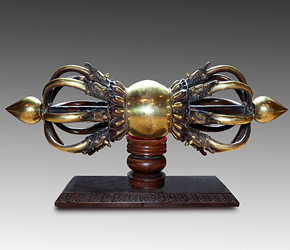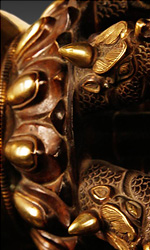 |
|
While it is interesting to see how pieces of this sort are used, it is equally important to know their history and background, or what makes them so meaningful. The name Vajra is actually A Sanskrit word which can be interpreted as either "thunderbolt" or "diamond." It is a ritual tool representing many concepts, the most important being firmness of spirit, spiritual power, and the capacity to break the bonds of worldly attachment. Used here, the thunderbolt symbolizes irrefutable force, and the diamond a substance so hard it can cut through anything else.
 |
|
The Vajra can be viewed as a material device - some call it a "weapon" - capable of destroying negative non-material concepts such as ignorance and doubt. At PRIMITIVE, we often say it is not about worshipping a statue or object, but instead, accessing the energy associated with the concept the statue or object represents. Thus, as the devout make offerings upon the Vajra, they are harnessing their own faith and knowledge (two more non-material concepts) to cut through the physical world to gain greater access and insight into the spiritual, non-material, or unseen world.
The concept of the Vajra began in antiquity in India with the advent of Buddhism. Because of its symbolic importance and relevance, its use spread to Hinduism as well. Nevertheless, as Buddhism manifested itself beyond India, it began to be used as a symbol and tool in just about every other Asian culture. The piece at PRIMITIVE is directly related to Tibetan Buddhism. In Tibetan, the Vajra is known as a Dorje (dorjay), which can be translated as “noble stone.” In this practice, it is a means to harness the indestructible forces of compassion and wisdom.
Authentic objects tell stories and once revealed can become relevant to our daily lives. At PRIMITIVE, we often say “all cultures are the same, we just express ourselves differently.” The Vajra is an expression of the human need to pursue spiritual beliefs. While it is emblematic of beliefs found in Buddhist cultures, it is relevant to the belief that positive concepts can overcome negative concepts. This understanding qualifies the Vajra as a beautiful, meaningful work of art, one which could easily be elevated to the status of heirloom.